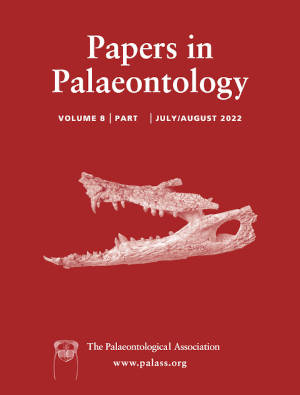Article: Late Ordovician (Katian) linguliform microbrachiopods from north-eastern Yunnan, South China
Publication: Papers in Palaeontology
Volume:
8
Part:
1
Publication Date:
2022
Article number:
e1407
Author(s):
Di Chen, Bing Huang, Wen-Jie Li, Rong-Yu Li, and Jia-Yu Rong
DOI:
10.1002/spp2.1407
Abstract
Abstract Linguliform brachiopods are a minor but distinctive component of the Palaeozoic Evolutionary Fauna. However, there is no formal research on Katian (Late Ordovician) linguliform microbrachiopods in South China. Fossils from the ‘Pagoda’, ‘Linhsiang’ and Daduhe formations, Wanhe section of Yunnan Province, South China, provide a unique opportunity to bridge the gap. Here, we report and systematically describe, for the first time, a deep-water Katian linguliform microbrachiopod association, including 13 species assigned to nine genera, namely Paterula cf. numerosa Popov, Hisingerella tenuis Holmer, Scaphelasma sp., Torynelasma? sp., Biernatia holmi Holmer, ?Biernatia maruiaensis Percival et al., Biernatia pseudoplana Percival et al., Biernatia wrighti Percival et al., Opsiconidion praecursor Popov et al., Opsiconidion sp., Eoconulus puteus Percival et al., Acanthambonia sp. and Nushbiella lillianae Holmer. To explore the composition and distribution model of global deep-water micromorphic linguliforms in the Katian, a dataset of occurrence of 40 genera from five superfamilies and 10 localities in Baltica, Avalonia, Australian Gondwana, Boshchekul Island Arc and South China is established. Compared with those of other localities, the Chinese association is dominated by Acrotretoidea with no taxon of Discinoidea or Paterinoidea. The global dataset is analysed using non-metric multidimensional scaling. The results indicate an endemic biogeographical pattern for the Katian linguliform microbrachiopods, which can be explained by oceanic circulation or environmental differences.
